The Strategy for Handling the Impact of Covid-19 Pandemic by Sanur Tourism Actors
on
E-Journal of Tourism Vol.9. No.2. (2022): 244-253
The Strategy for Handling the Impact of Covid-19 Pandemic by Sanur Tourism Actors
I Putu Angga Suta Pramana Putra1*, Agung Suryawan Wiranatha2, I Gusti Ayu Oka Suryawardani2
1Master Program in Tourism, Udayana University 2Centre of Excellence in Tourism, Udayana University
*Corresponding Author: sutaangga@gmail.com
DOI: https://doi.org/10.24922/eot.v9i2.92881
Article Info
Submitted:
August 25th 2022
Accepted:
September 25th 2022
Published:
September 30th 2022
Abstract
The COVID-19 pandemic has given a negative impact on Sanur tourism, therefore a strategy for handling the impact of COVID-19 pandemic is needed for the restoration of Sanur tourism. This study aims to determine the strategies of tourism actors in handling the impact of COVID-19. This research uses a qualitative approach with a case study research strategy. The method used is observation, interviews, questionnaires and documentation. The theory used is perception theory to identify visitor perceptions and sustainable tourism theory to analyze the effectiveness of implementing strategies for Sanur tourism actors. The results show that the visitor's perception of the image of the Sanur destination is very good, it can be seen from the information received by visitors from Sanur tourism actors is clear, and the end understands the risks and threats when visiting so that visitors do not want to change their travel plans to Sanur. The strategies carried out by Sanur tourism actors are Reduction, Readiness, Response and Recovery. The effectiveness of implementing the strategy is seen from the environmental aspect, namely improving and rejuvenating the environment, the economic aspect of increasing tourist visits and the social aspect of growing awareness (awareness) of tourism actors and the community in the Sanur destination of the risks caused by disasters. The government and tourism actors need synergy in dealing with the impact of disasters on tourism so that they can help and speed up the handling process and minimize the negative impacts that arise.
Keywords: tourism actors strategy; covid-19; tourism crisis.
INTRODUCTION
Background
Tourism is defined as a journey or travel to a certain place or several other places, so that a trip is very necessary for tourism activities, therefore any factors that hinder travel will indirectly have an
impact on tourism industry. International issues, such as COVID-19 (Corona virus) pandemic is an example of this impact. This kind of disaster has again shown the vulnerability of the tourism industry (Jiang & Ritchie, 2017). Based on Act No. 24 Year 2007, disasters can be grouped into three causes, namely: 1. Natural disaster, it
is a disaster that originate from natural phenomena such as floods, earthquakes, and volcanic eruptions, tsunamis and others. 2. Non-Natural Disaster, an event caused by non-natural factors, including technological failures, modernization failures, epidemics, and disease outbreaks. 3. Social Disasters, are disasters caused by events or series of events caused by humans, including social conflicts between groups, communities and terrorism.
Various disasters greatly affect the sustainability of tourism. The causes of the obstruction of a tourism travel include Tsunami disaster (Ghaderi & Henderson, 2013), earthquakes (Huan et al, 2004), terrorist activity (Bowen et al. 2014; Samit-aset al. 2018), extreme climate change (Becken, 2005), health and security issues or conflicts (Fotiadis & Huan, 2014), and so on. There are several disasters that have directly Shaked up tourism, such as terrorism (the tragedy of the hijacking of American Airline Flight 11 which crashed into the World Trade Center Building in North Tower on 11 September 2001, the Bali 1 bombing incident in 2002 and the Bali 2 bombing in 2001). 2005, Madrid train bombings in 2004, London public transport bombings in 2005, Mumbai bombings in 2008, Boston bombings in 2013, Kenya mall attacks 2013). Earthquake and tsunami natural disasters (Aceh Earthquake and Tsunami in 2004, Japan Tsunami in 2011, Tsunami Christchurch in 2011). Hurricane and cyclone natural disasters (Hurricane Katrinia of 2005, Hurricane Huricane Sandy of 2012). Volcanic eruptions (Mount Agung Bali in 2017), global financial and economic crises in 20082010 and disasters or disease pandemics (Foot and mouth in 2001, Serve acute respiratory syndrome [SARS] in 2003, Avian Influenza [ H5N1] in 2003, and those that we have experienced from 2019 up to this present is the Coronavirus Disease of 2019 [SARS-CoV2] in 2019 until now.
Bali is a province in Indonesia that relies heavily on tourism activities, therefore seeing the vulnerability of tourism of
course also makes Bali very vulnerable to the impact of disasters caused by natural, non-natural or social disasters. In the last 10 years Bali has been recorded to have experiences of several disasters with a fairly large capacity; in 2002 Bali and its tourism were again shaken by acts of terrorism. More than 200 people were killed in this bombing incident, while more than 200 others were seriously injured and having minor injuries (edun-itas.com 2005). As a result, there has been a decline in the number of tourists coming to Bali, three months after the Bali bombing, the condition of Bali's tourism has not shown any signs of recovery. The condition of Bali's tourism at that time, especially in Denpasar City was getting uncertain, hotel occupancy rates were reduced, there were cancellations due to tourists' fear of the threat of terrorism, the average hotel occupancy was still below 30%. Meanwhile, the number of foreign tourist visits at that time ranged from 1500 to 2000 people per day. (Denpasar-kota.com 2006). The absence of tourists, both domestic and international, causes the hotel business to have a very bad impact. These impacts even lead to the loss of business potential and it is unclear when will the Covid-19 pandemic situation soon end (Suryaningsih, et al 2021).
In addition, one of the disasters that shaked Bali up and its tourism was a natural disaster caused by the eruption of the highest mountain on the island of Bali, namely Mount Agung in 2018. This mountain is an active volcanic mountain, however, Mount Agung Bali was last recorded as a volcanic mountain that erupted in 1963, to be precise, on March 17, 1963. Consequently, there were around 1,600 people declared dead in the eruption (Kompas.com 2021). In 2018 Mount Agung Bali erupted again, the threat of the eruption of Mount Agung resulted in many tourists canceling their travel plan to visit Bali, other than that, tourists who had traveled and still in Bali made their visit time shortened. Then this condition was exacerbated by the closure of the I Gusti Ngurah e-ISSN 2407-392X. p-ISSN 2541-0857
Rai International airport for two days due to volcanic ash eruptions which disrupted flights, this also resulted in the closure of access for foreign tourists who wanted to come directly to Bali. These conditions have caused the hotel room occupancy rate in Bali to reach 15%. Besides the eruption of Mount Agung, in August 2018 the island of Bali experienced 7 SC magnitude earthquake was followed by several aftershocks and the epicenter at that time was located on the island of Lombok.
Currently, Bali tourism is being tested again with the COVID-19 pandemic, the COVID-19 outbreak has begun to endemic since the end of 2019 in Wuhan, China, is now spreading throughout the world. Until mid-March 2020, the Corona virus has infected as many as 185 countries with more than 270 thousand people.
The current impact of the COVID-19 pandemic on the island of Bali is harder when compared to the Bali bombings and the eruption of Mount Agung. Because, during Mount Agung erupted, the occupancy rate of hotels in southern Bali such as Badung, Denpasar and Gianyar still reached 60%, this was due to the dangerous radius of the eruption of Mount being only 12 KM away and when Bali experienced the Bali BOM I and II tragedy 10 last year the hotel room occupancy rate at that time was still at 20%, quoted from Bisnis.com (2020). The chairman of the Indonesian Hotel and Restaurant Association or PHRI of Badung Regency IGA Rai Suryawijaya said that Bali's economy is currently the worst condition in existing history, because the hotel occupancy rate reaches zero (zero).
The vulnerability of a destination to disasters that occur often leads to strengthening mitigation plans to equalize the perception that tourism area development cannot be separated from disaster mitigation. Even though there is no benchmark or best method in tourism recovery after a disaster or crisis. Models that have been effective in dealing with some past disasters may not work for other planners (Mansour, 2013). http://ojs.unud.ac.id/index.php/eot
In addition, the development of a tourism area without preparing disaster mitigation can have an impact on the high risk or potential impact of losses and victims caused by disasters in the future. We can see several approaches in handling disasters and minimizing the impact of victims from the disaster, such as the presence of evacuation signs (warnings/signs/danger signs, coast guard posts/Search and Rescue (SAR)/ Regional Disaster Management Agency (BPBD), loudspeakers, and early warning systems), evacuation routes, gathering points, and health protocols and logos such as the application of CHSE in an effort to minimize the spread of the COVID-19 virus in a tourist destination. Therefore, it is very important to know the perception of tourists in visiting a destination and to examine the handling strategies that are carried out in overcoming the impact of disasters, in this case the researchers conducted research in Sanur tourism area.
Sanur tourism area is very interesting to study because in terms of control, they have their own organization called YPS (Sanur Development Foundation), YPS's involvement is enermous in Sanur tourism development. It is certain that in implementing a strategy for handling disaster impacts, it is necessary to have support from tourism actors themselves, such as YPS. In addition, Sanur has a very strategic and important position for the city of Denpasar because Sanur contributes 40% of PAD (Regional Local Revenue) and 80% of the total PHR (Hotel and Restaurant Tax) in Denpasar is generated in Sanur. very large (Balipost.com, 2019).
RESEARCH METHODS
The theory of sustainable tourism development or sustainable tourism development is defined as a process in development that is carried out without spending and destroying resources. In relation to this research, the handling strategy by the government will affect the implementation of the industry as actors in the field. The form
handling strategies to restore Sanur tourism. Case study research analysis. The theory applied to determine the direction, context, and guidelines in carrying out research activities.
RESULT AND DISCUSSION
The Visitors' Perception of Destination Image
In this research, visitors' perceptions of the destination's image were determined randomly for visitors who traveled in Sanur Tourism Area during the time or during the ongoing COVID-19 pandemic, from November 2019 until the time this research was conducted (April 2022). This research took a sample of 40 respondents in which all respondents had the required criteria.
Referring to the results of the questionnaire, the main purpose of visitors visiting Sanur is mostly for vacation and relaxation where the figure obtained is 82.5% and is a very significant percentage when compared to other figures. The visitors have different perspectives on each individual in assessing a destination. It is intrinsic to human beings based on experiences, desire and knowledge of a perceived object.
Of the 40 respondents, the majority of respondents received information related to COVID-19, through the internet, with a significant percentage compared to other figures, it reached 67.5%, while the information obtained through friends was 32.5%.
of the effectiveness of the implementation of the strategy ca be seen from the three components of sustainable tourism indicators, namely environmental, socio-cultural and economic aspects. In this case, the three core indicators are identified through the tourism industry, the responsibility of local communities, and environmental caretakers who are implementers in the field.
This research was conducted in the Sanur Tourism Area, Eastern Denpasar District, Denpasar City of Bali Province. The types of data used in this study are qualitative data and quantitative data. The primary data of this study were obtained directly from interviews conducted with informants, namely tourism actors, the government and related parties regarding strategies in handling the impact of the COVID-19 pandemic on Sanur tourism. Researchers also applied online desk research by collecting written data on the internet from various trusted sources.
The determined informants include:
(1) Government: Denpasar City Tourism Office; (2) Tourism organizations: Sanur Development Foundation (YPS); (3) Tourism industry actors of Sanur tourism area: hotel accommodation providers, food and beverage business providers and tourist attraction service providers. In addition, a number of tourists who made visit the tourism area of Sanur. The sample was determined by purposive sampling based on the time of visit (when the pandemic was still ongoing) which was then taken by accidental sampling from tourists who were willing to be respondents. The number of the voluntary tourists were 35 tourists. The data collection techniques in this study include observation, interviews, and documentation.
The data analysis is an activity of searching or tracking of patterns, in this research, the researchers tried to find out how the COVID-19 pandemic has affected Sanur tourism activities significantly in the form of decreasing number of visits, then encouraged tourism actors to implement http://ojs.unud.ac.id/index.php/eot 247
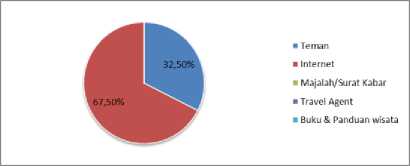
Figure 1. The Sources of COVID-19 Information
(Source: Research Results, 2022)
Based on the results of the study, there are 43% of visitors who find out information related to COVID-19 while they are still in their area or country of origin, 32% find out the information while they are in other areas of Bali and 25% who find out information when they are in Sanur.
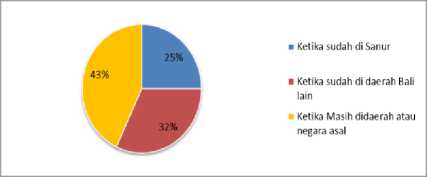
Figure 2. The presence of visitors’ finding out about COVID-19 information (Source: Research Result, 2022)
This shows that the readiness of the visitors before visiting Sanur showed that they have understood or quite aware of the risks that may be faced during their visit to Sanur.
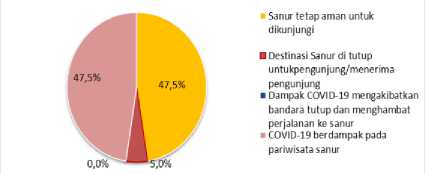
Figure 3. The Information Received by
Visitors Regarding COVID-19 in Sanur (Source: Research Results, 2022)
Based on Figure 3. above, it shows that the information received by visitors about COVID-19 in Sanur is varied, consequently, the information causes different perceptions by each individual respondent. If it is viewed from the information received by respondents, the statement was dominant in "COVID-19 has an impact on Sanur tourism with a percentage of 47.5%" and "Sanur remains safe to visit". The unstable tourism activities are very likely to occur when one of the 4A elements of tourism experiences obstacles. One of them is Amenity.
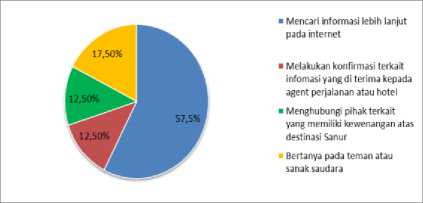
Figure 4. The Visitors' Responses to Information Received Regarding COVID-19 in Sanur
(Source: Research Results, 2022)
Of the 40 respondents, 57% of them responded by searching for more information on the internet, 17.5% of them responded to asking friends or relatives, 12.5% confirmed information received from travel agents or hotels and 12.5% contacted related parties who have the authority in Sanur. This shows that the internet media has a very good role in people's lives as a means of information that is easy and very fast to access or obtain.
Perception of the Risks and Dangers of Covid-19 in Sanur.
Of the total respondents, only 10% of respondents stated that Sanur was a risk to visit. However, 90% of respondents stated that Sanur is not at risk to visit. There were some opinions from respondents stating that Sanur is still being safe to visit, among others, Sanur is one of the green zones for Bali tourism, which means that Sanur has special attention in handling COVID-19.
The Change of Itinerary
It refers to uncertain situations and conditions and also policy directions that change very quickly and affect the state of opening and closing of tourism destinations, of course this affects changes in visit plans that have been previously planned by visitors or potential visitors.
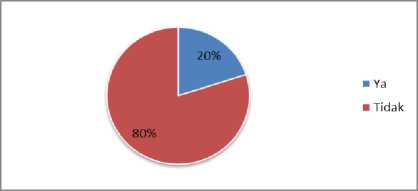
Figure 5. The Changes in Travel Plans After Finding Out Information Regarding COVID-19 in Sanur
(Source: Research Results, 2022)
Figure 5. shows that of the 40 respondents who found out the information related to COVID-19 in Sanur, 80% of them said they had not changed their travel plans and 20% of them said they had changed their travel plans.
The Impact of COVID-19 Pandemic Toward Tourism of Sanur
The Tourism actors in Sanur remain optimistic that COVID-19 will end soon because the majority of the population of Sanur depend on the tourism economy for their livelihood, this chain effect has resulted in many sectors being paralyzed. The impact of Covid-19 pandemic on the economy and tourism of Sanur, which is very dependent on this sector is becoming increasingly significant, notified by the more decrease number of tourists arrival.
The Strategies of Tourism Actors in Sanur Tourism Area
Reduction in this research is a step or stage of reducing the impact of disaster or the COVID-19 pandemic caused in the initial phase by detecting and identifying sources of risk to prevent the emergence of a tourism crisis. The reduction strategy steps taken by Sanur tourism actors against the impact of the COVID-19 pandemic is by having the implementation of the Enforcement of Restrictions on Community Activities (PPKM) in Sanur Tourism Area by Denpasar City Government.
Readiness in this research is a step to reduce the impact of the crisis in Sanur
tourism area and to facilitate tourism to run normally again. Based on the results of interviews with the government and tourism institutions in the Sanur tourism area, particularly in terms of disaster management, the government and Sanur tourism institutions do not yet have an SOP in the event of a similar disaster. However, the government and tourism institutions form a network so that this can be a liaison as a coordinating medium. As for other preparedness steps taken by the tourism industry manager, Inna Grand Bali Beach Sanur in reducing the impact and efforts to reduce the spread of COVID-19 in Sanur, by implementing Staff Training & Property Security. Staff Training and Property Security is very important to be applied at the Readiness stage, at this readiness stage it will be seen how the readiness of the management is ready to provide security and comfort guarantees for tourists and staff on duty.
The response stage is carried out by the management of Inna Grand Bali Beach Sanur where the management complies with and implements the CHSE certification standard. CHSE stands for Cleanliness (cleanliness), Health (health), Safety (security), and Environment Sustainability (environmental sustainability). The government's response in this case is to help hotels and restaurants that are experiencing financial problems due to the Corona Virus Disease 2019 (COVID-19) pandemic, as written in the Denpasar Mayor's Decree 188.45/1105/HK/2020 concerning the application of recipients tourism grants to hotels and restaurants phase I. Business actors in tourism industry in Sanur cut operational costs such as staff costs by laying off employees and laying off Daily Workers (DW), however the company and management does not terminate employment (PHK) on contract and permanent employees.
Recovery means the stage of recovery in handling the tourism crisis. Some of the actions taken by tourism actors in Sanur Tourism Area are as follows: data e-ISSN 2407-392X. p-ISSN 2541-0857
collection of all tourism workers for COVID-19 vaccination; Promotion and Event (Hybrid Table Top); Price Adjustments and Added Value for Visitors.
The Submission of Information on Handling COVID-19 to Visitors and Prospective Visitors
In this research, the effectiveness of implementing the strategy will be seen through the level of achievement in conveying handling information
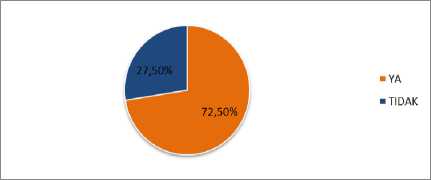
Figure 6. Visitors find out information on Handling by Sanur Tourism Actors Related to COVID-19
(Source: Research Results, 2022)
Figure 6. shows that of the 40 respondents 72.5% of them aware of the handling information and 27.5% of them do not aware of information on handling COVID-19 from tourism actors in Sanur. This shows the success of tourism actors in conveying information related to handling COVID-19 in Sanur. The factors that support the successful delivery of information by Sanur tourism actors, include; (1) the information conveyed properly and is supported by information technology such as social media news and social networking Face Book, Instagram, etc., (2) The information provided is very updated and accurate according to the situation in the field. (3) The establishment of synergy between the government and actors in the tourism industry as well as Sanur tourism organizations in conveying information.
From these explanations, it shows that between the government and the actors in the field, they have disseminated information of handling optimally to visitors and potential visitors. The latest
information related to the situation in the field not only gives the impression of readiness of the Tourism Destination to accept visitors, it also builds trust for visitors to visit a destination.
The Effectiveness of Strategy Implementation
In this research, the effectiveness of implementing strategies by Sanur Tourism Actors will be explained using the concept of sustainable tourism or Sustainable Tourism. The concept of sustainable tourism according to Sadler and Wight (in Hall, 2003) describes the three basic components of sustainable tourism, namely community base economics, conservation with equity & environment economy integration.
-
1. Social Goals
Social goals are indicators of the concept of sustainable tourism which means benefits for local communities, planning, health, participation, labor and regarding visitor satisfaction. Viewed from the impact of strategy implementation done by tourism actors of Sanur, it gives a positive impact on local people who are staff at hotels or restaurants in Sanur socially. With the opening of Sanur beach and all existing tourism facilities visitors started to come. Although there were still not many visitors from abroad, we may notice that there were quite a number of local tourists. Tourism actors have begun to reorganize and maximize existing facilities to prepare for tourism returns to normal.

Figure 7. The Perceptions to Recommend Travel to Sanur related to the Impact of the COVID-19 Pandemic (Source: Research results, 2022)
Figure 7. shows that from 40 respondents, 87.5% of respondents stated that they would recommend a trip to Sanur during the COVID-19 pandemic. Another very positive perception can be seen in Figure 7.5, from 40 respondents, 82.1% of respondents stated that COVID-19 was not a threat when visiting Sanur Tourism Destination. Thus, it can be seen that on the basis of the perception, visitors do not feel threatened when visiting Sanur Tourism Destinations, visitors feel that Sanur Tourism Destinations are worthy of being recommended to friends, relatives or other potential visitors. In addition, one's motivation and the attractiveness of a destination which has a strong allure will make potential visitors get more motivated to visit a tourism destination.
-
2. Environment and Resource Goals
The effectiveness of the implementation of strategies to deal with the impact of COVID-19 on environmental aspects can be seen from the improvements to tourism support facilities in the Sanur Tourism Area, both in terms of spatial planning and infrastructure.
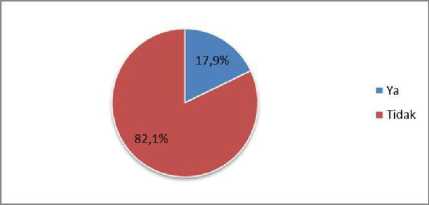
Figure 8. The Visitors' Perceptions Concerning the Threat of COVID-19 Pandemic in Sanur (Source: Research Results, 2022)
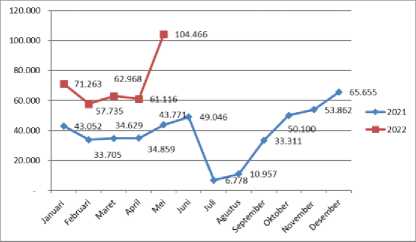
Figure 9. Data on the Number of Tourist Visits in Sanur Tourism Area (Source: Bali Provincial Tourism Office, 2022)
The increase in the number of tour-
3. Economic Goals
The economic goals referred to in this research are to have economic benefits for local communities, stakeholders and have an impact on the tourism industry economy. Based on tourist visits to Sanur Tourism Area, the form of implementing the strategy carried out by Sanur tourism actors at the recovery stage has given positive results although it is still not stable. There has been an increase in the number of tourist visits to Sanur tourism area, a comparison between 2021 to May 2022, starting to show significant numbers and leading to positive growth.
ists visits greatly affects the economy of the community in Sanur tourism area as well as Regional Local Revenue (PAD) and Hotel and Restaurant Taxes (PHR). At the time of COVID-19 outbreak, hotel occupancy ranged from 10% to at worst zero, however, along with the increase in tourist visits, the room occupancy rate and the purchase of tour packages also began to be accepted by tourism service providers in the tourism area, Sanur. In addition, the improvement in the economy will not only be felt by people who work in the tourism industry but also have an impact on tour service providers, local traders, craftsmen, suppliers and even community agriculture will also get a market if hotels and restaurants started to be opened and receive tourists or visitors. Another positive impact that is directly felt in Sanur tourism area is that the tourism industry has begun to 251 e-ISSN 2407-392X. p-ISSN 2541-0857
reopen job vacancies, especially for local communities.
CONCLUSION AND SUGGESTION
Conclusion
From the results of visitors' perceptions of the image of destinations in Sanur tourism area concerning the handling of COVID-19 by Sanur tourism actors, most of the visitors considered that Sanur tourism area was a safe place to visit. The strategies of tourism actors in Sanur tourism area in handling the impact of the COVID-19 pandemic are as follows: Reduction strategy carried out by implementing PPKM or imposing restrictions on community activities in order to suppress the impact caused and the spread of COVID-19. The Readiness strategy or preparedness stage was carried out by tourism actors by implementing staff training and property security. The Response Strategy was carried out by tourism actors to be able to start and run the tourism industry operations during the tourism crisis; the strategies include: (1). Response to the implementation of CHSE. (2). The government's response is to distribute tourism grants. (3) . Provide Help desk and information in the Sanur tourism area. (4) Response from the tourism industry in reducing operational costs.
The recovery strategy carried out by Sanur tourism actors are as follows: (1) having data collection of all Sanur tourism workers for COVID-19 Vaccination. (2) Conducting hybrid promotions and events. (3) Adjusting price and providing added value to tourists by the Sanur tourism industry manager. The effectiveness of implementing the strategy of tourism actors in Sanur Tourism Area is seen from the three pillars of sustainable tourism, namely: (1) The positive impact on socio-culture is seen from the opportunity for local people to return to work in the tourism industry. (2) The economic impact can be seen based on the increase in tourist visits, which gave an influence on the income of the community, both workers in the tourism industry
and local communities who have businesses around them. (3) Environmental aspects impact such as environmental conservation and resource utilization as well as maintaining tourism supporting facilities.
Suggestion
Based on the conclusions described above, some recommendations can be provided regarding the strategy of tourism actors in handling the impact of COVID-19 in Sanur. The recommendations are: recommendations to the government, the handling that must be given special attention is the application of disaster mitigation standards that are specifically divided based on disaster groups along with the steps or stages of handling. Other recommendations, the government or related agencies can also implement disaster preparedness training to reduce casualties, material and infrastructure damage caused by disasters. The recommendation that researchers can give is that every tourism industry should have a reserve fund to deal with a disaster. In dealing with disasters, the community can support the government or stakeholders in disseminating accurate information to tourists.
REFERENCES
Chok, S., Macbeth, J. & Warren, C. (2007). Tourism as a Tool for Poverty Alleviation: A Critical Analysis of „Pro-Poor Tourism‟ And Implications for Sustainability. Current Issues in Tourism.
Kasali, Rhenald. 1994. Manajemen Public Relations: Konsep Dan Aplikasinya di Indonesia. Jakarta: Pustaka Utama Grafiti.
Lin, D. & Simmons, D. (2017). Structured inter-network collaboration: Public participation in tourism planning in Southern China. Tourism Management.
Sesra, Budio (2019). Strategi Management Sekolah: Jurnal Menata Volume 2, No. 2, Juli- Desember 2019.
Sugiyono. (2016). Metode Penelitian Kuantitatif, Kualitatif dan R&D. Bandung: PT Alfabet.
Suryaningsih, I. A., & Suryawardani, I. G. A. O. (2021). Strategi Bertahan Hotel Berbintang dalam Menghadapi Situasi Covid-19 di Kabupaten Badung, Bali. Jurnal Kajian Bali (Journal of Bali Studies), 11(2), 387-406.
Tosun, C. (2000). Limits to community participation in the tourism development process in developing countries. Tourism Management.
Tohirin. 2011. Metode Penelitian Kualtatif dalam bimbingan dan konseling. Jakarta: Raja Grafindo Persada.
http://ojs.unud.ac.id/index.php/eot
253
e-ISSN 2407-392X. p-ISSN 2541-0857
Discussion and feedback